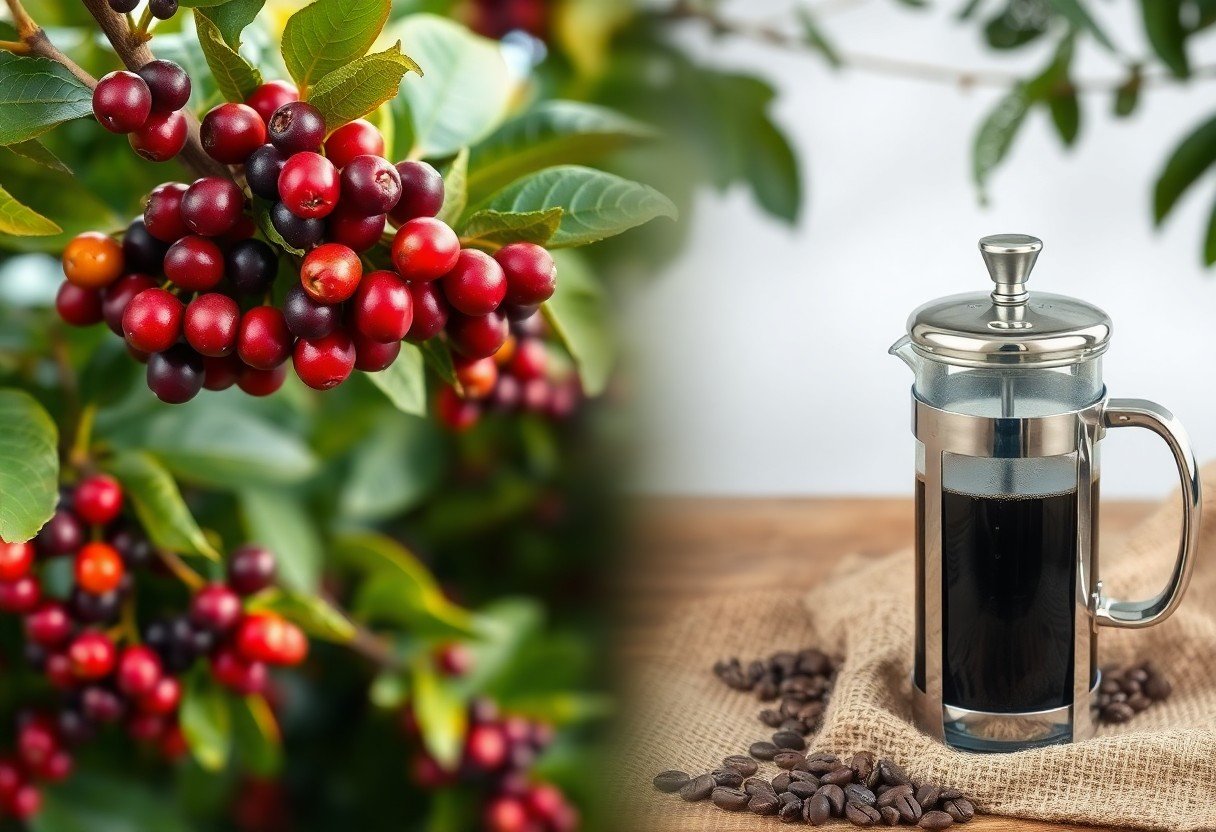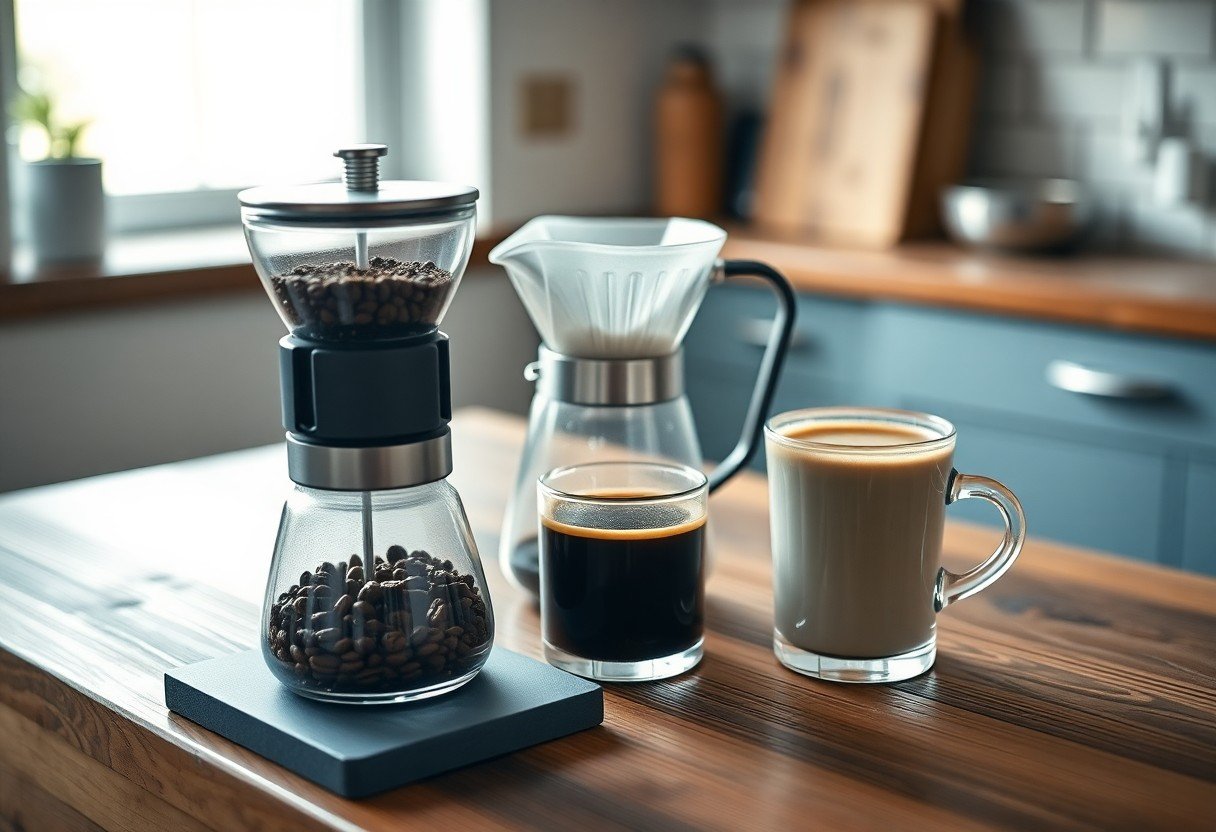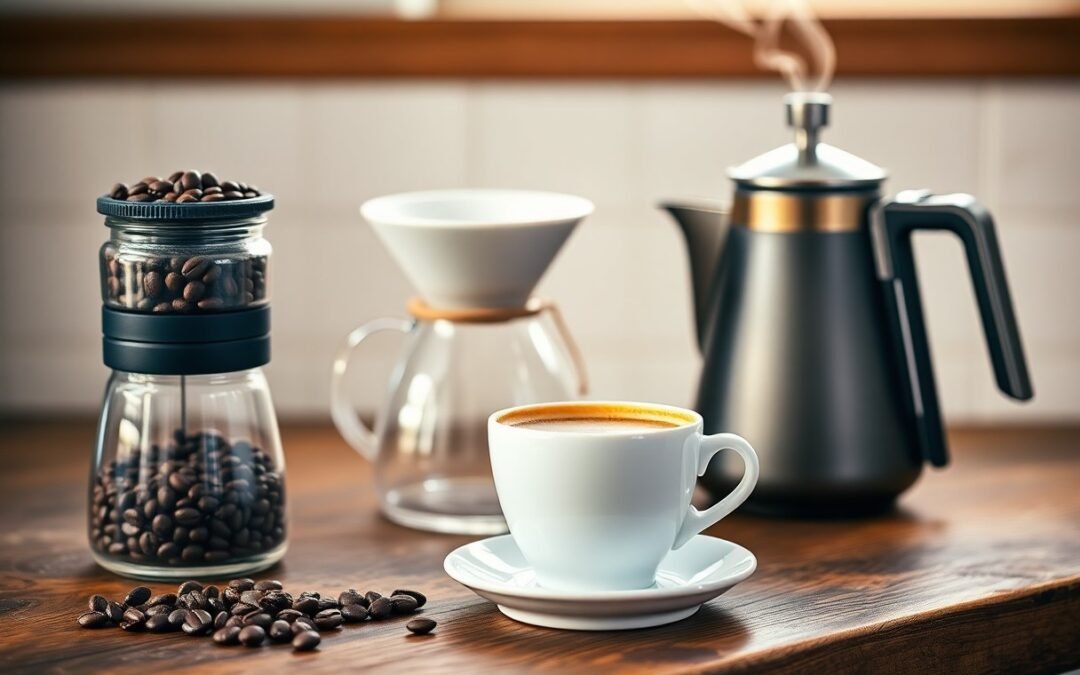Brew your way to a refined coffee experience that rivals the best cafés. By understanding the selection of quality beans, the importance of precise measurements, and the optimal brewing methods, you can elevate your daily cup into a sophisticated ritual. This guide will walk you through each step, ensuring you unlock the full potential of your coffee at home. Get ready to indulge in a rich, flavorful brew that reflects your personal taste and expertise.

The Journey of Coffee: From Tree to Cup
Every cup of coffee starts as a cherry on a coffee tree, requiring careful cultivation, harvesting, and processing to reach your mug. Coffee trees thrive in specific climates and altitudes, predominantly found in the “Bean Belt,” which encircles the globe between the Tropics of Cancer and Capricorn. Once the cherries are harvested, they undergo methods like wet or dry processing, affecting the final flavor profile. This transformative journey enhances the coffee’s character, ensuring that each step contributes to the sophisticated taste you savor at home.
Understanding Coffee Varietals and their Flavors
Coffee varietals significantly influence flavor, aroma, and mouthfeel. Varietals such as Arabica and Robusta present different taste characteristics, with Arabica showcasing delicate nuances like jasmine and berry, while Robusta tends to be bold and earthy. Within these categories, there are numerous sub-varietals, each contributing unique qualities. Exploring these varietals allows you to tailor your brewing experience, enhancing the complexity and richness of your coffee.
The Importance of Origin: Terroir and Processing Methods
The origin of your coffee beans plays a pivotal role in defining their flavor profile. Different regions impart distinct characteristics, affected by factors like soil quality, altitude, and climate. Processing methods, such as washed or natural, also influence flavors. For example, Ethiopian coffees, often processed naturally, can exhibit fruity and wine-like profiles, while washed coffees from Colombia tend to be cleaner and brighter, showcasing their terroir more distinctly.
Terroir, the unique environmental factors of a coffee-growing region, encompasses everything from the local climate and elevation to the mineral content of the soil. For instance, coffee from high-altitude regions often has pronounced acidity and refined flavors, whereas lower altitude beans may be more rounded and less complex. Together with the processing method—where the cherry is either fermented and washed or dried with the fruit intact—these elements create a unique identity for each coffee. Experimenting with different origins and processes allows you to discover a wide array of tastes and aromas, elevating your home brewing experience.
Choosing Quality Beans: What to Look For
Quality beans are the foundation of any great cup of coffee. Look for beans that are sourced from reputable farms known for sustainable practices, as these often yield superior flavor profiles. Single-origin beans typically offer distinct tastes linked to their geographic region, while blends may provide complexity. Consider the bean type, such as Arabica for sweetness and acidity or Robusta for a stronger, bolder flavor. Your choice of beans can significantly elevate your brewing experience, ensuring each cup reflects the unique characteristics of its origin.
How to Read Labels: Freshness and Roasting Dates
Pay close attention to the labels on coffee packaging. Freshness is vital for flavor, so opt for beans with a recent roasting date, ideally within two weeks of purchase. Look for coffee labeled as “roasted on” rather than “best by” dates, as this provides a clearer indication of freshness. Additionally, check for storage methods; bags with one-way valves are best, as they prevent the escape of gases while keeping air out, preserving the beans’ quality.
Selecting the Right Roast Profile for Your Tastes
The roast profile can dramatically influence your coffee’s flavor and aroma. If you enjoy bright, fruity notes, light roasts with higher acidity will likely suit your palate. Medium roasts balance sweetness and acidity, often yielding a caramel-like flavor. Dark roasts, on the other hand, provide bold and smoky profiles, appealing to those who prefer a robust taste. Experimenting with different roasting levels allows you to discover the nuances of each roast, ultimately honing in on your personal favorite.
Different roast profiles can enhance or diminish flavors you appreciate in coffee. Light roasts showcase the inherent characteristics of the bean and are perfect for highlighting floral or fruity undertones. Medium roasts offer balance, making them versatile and accessible for a broad range of tastes, whereas dark roasts are intense, offering deep chocolate or burnt sugar flavors. Understanding your preferences will help you select beans that align with your unique flavor profile, transforming each cup into a customized coffee experience.

Grinding for Greatness: The Key to Flavor Enhancement
Your grinding technique plays a vital role in determining the flavor profile of your coffee. A precise grind not only extracts the best flavors but also affects the overall aroma and mouthfeel. Whether you’re brewing a rich espresso or a smooth French press, mastering grind size can elevate your coffee experience to new heights.
The Science of Grind Size: Coarse vs. Fine
The grind size influences extraction rates, which directly impacts taste. Coarser grinds, suitable for methods like French press, provide a slower extraction, resulting in smoother flavors. Conversely, finer grinds, ideal for espresso, allow for quick extraction, producing a rich and intense brew. Understanding these differences helps you achieve the perfect cup tailored to your preferences.
Tools of the Trade: From Manual to Electric Grinders
Your choice of grinder significantly affects grind consistency and flavor. Manual grinders, while affordable and simple, require more effort but offer excellent control over grind size. Electric grinders save time and can consistently achieve perfect sizes; however, quality varies, so investing in a good model pays off. Each type has its merits, depending on your brewing style.
When considering grinders, assess the available options based on your needs. Manual grinders often feature ceramic burrs, which allow for even grinding and a customized experience. They’re compact and portable, ideal if you savor the ritual of grinding coffee beans. Electric grinders come with various settings for precise adjustments, providing convenience and speed, especially beneficial for those with busy schedules. The best choice ultimately aligns with how you intend to brew and your daily coffee habits.
Brewing Techniques: Elevating Your Coffee Game
Mastering various brewing techniques brings depth and complexity to your coffee experience at home. Each method offers unique nuances that can highlight your chosen beans’ distinct characteristics. From controlling brew time to experimenting with different techniques, refining your approach will lead to a more sophisticated cup—one that resonates with your personal taste preferences.
Popular Methods: Pour-Over, French Press, and Espresso
Pour-over, French press, and espresso are three popular brewing methods, each delivering a different taste experience. Pour-over allows precise control over extraction, enhancing clarity and brightness. French press results in a full-bodied cup with rich, robust flavors, while espresso packs an intense punch with concentrated flavors and creamy textures. Exploring these methods will enable you to discover your favorite style.
Mastering Water Temperature and Brew Time
Water temperature and brew time are integral to achieving optimal extraction and flavor balance. Ideal water temperature ranges from 195°F to 205°F, allowing you to draw out the perfect flavor oils without over-extracting bitter notes. Brew times vary by method: pour-over typically takes 3-4 minutes, French press around 4 minutes, and espresso requires about 25-30 seconds. Adjust these parameters to suit the beans and your taste preferences.
| Brewing Method | Optimal Water Temperature |
| Pour-Over | 195°F – 205°F |
| French Press | 195°F – 205°F |
| Espresso | 190°F – 200°F |
Fine-tuning water temperature and brew time significantly impacts flavor extraction. For instance, brewing at lower temperatures can emphasize sweetness, whereas higher temperatures may bring out acidity. Experimenting with these variables allows you to find the perfect equilibrium suited to your beans. Keeping a consistent brewing routine will also help you hone your technique, leading to repeatable, high-quality cups of coffee.
| Brewing Method | Optimal Brew Time |
| Pour-Over | 3-4 minutes |
| French Press | 4 minutes |
| Espresso | 25-30 seconds |
Enhancing the Experience: A Symphony of Additives
Additives can elevate your coffee experience, transforming a simple brew into a complex flavor journey. By thoughtfully incorporating different elements, you’ll unlock new dimensions in taste and aroma. From milks to sweeteners, each addition plays a vital role in crafting your perfect cup.
Exploring Milk Options: Whole, Almond, Oat, and Beyond
Your choice of milk significantly influences coffee’s overall flavor. Whole milk adds creaminess and richness, while almond milk brings a subtle nuttiness. Oat milk, with its naturally sweet profile, provides a velvety texture, making it a favorite among baristas. Don’t shy away from experimenting with coconut or hemp milk for unique twists.
Experimenting with Flavors: Syrups, Spices, and Unique Combinations
Infusing flavors into your coffee can lead to delightful discoveries. Syrups such as vanilla, caramel, or hazelnut add sweetness, while spices like cinnamon or nutmeg introduce warmth and depth. Consider combining unexpected flavors, like adding a dash of cocoa powder for a mocha twist or a sprinkle of cardamom for a Middle Eastern-inspired brew.
Incorporating flavored syrups opens up a realm of possibility beyond the standard offerings; a few pumps of lavender syrup can create a floral note that beautifully complements your brew. Spice blends, such as chai or pumpkin spice, can also turn your cup into a seasonal treat. For those adventurous at heart, try pairing coffee with citrus zest or a pinch of sea salt to enhance sweetness and round out the flavor profile, ensuring every sip is an experience unto itself.
Summing up
The journey from beans to brew is an art form that, with the right knowledge and equipment, you can master at home. By carefully selecting quality beans, grinding them to the perfect consistency, and meticulously brewing your coffee, you elevate each cup into a sophisticated experience. Pay attention to factors like water temperature and brewing time to unlock the full potential of your coffee. With practice and passion, you can transform your daily ritual into a delightful exploration of flavor and aroma.
FAQ
Q: What type of beans should I use for a sophisticated cup of coffee?
A: Opt for high-quality Arabica beans, as they typically offer more complex flavors. Look for single-origin options for distinct taste profiles.
Q: How should I store my coffee beans to maintain freshness?
A: Store beans in an airtight container in a cool, dark place. Avoid exposure to light, air, and moisture to keep them fresh for longer.
Q: What grind size is best for home brewing?
A: The grind size depends on the brewing method. For drip coffee, use a medium grind; for espresso, a fine grind; and for French press, a coarse grind.
Q: What water temperature is ideal for brewing coffee?
A: The optimal water temperature is between 195°F to 205°F (90°C to 96°C). This range extracts flavors effectively without burning the coffee.
Q: How can I enhance the flavor of my coffee at home?
A: Experiment with different brewing methods, adjust the coffee-to-water ratio, and try adding natural flavorings like cinnamon or vanilla for a unique twist.

